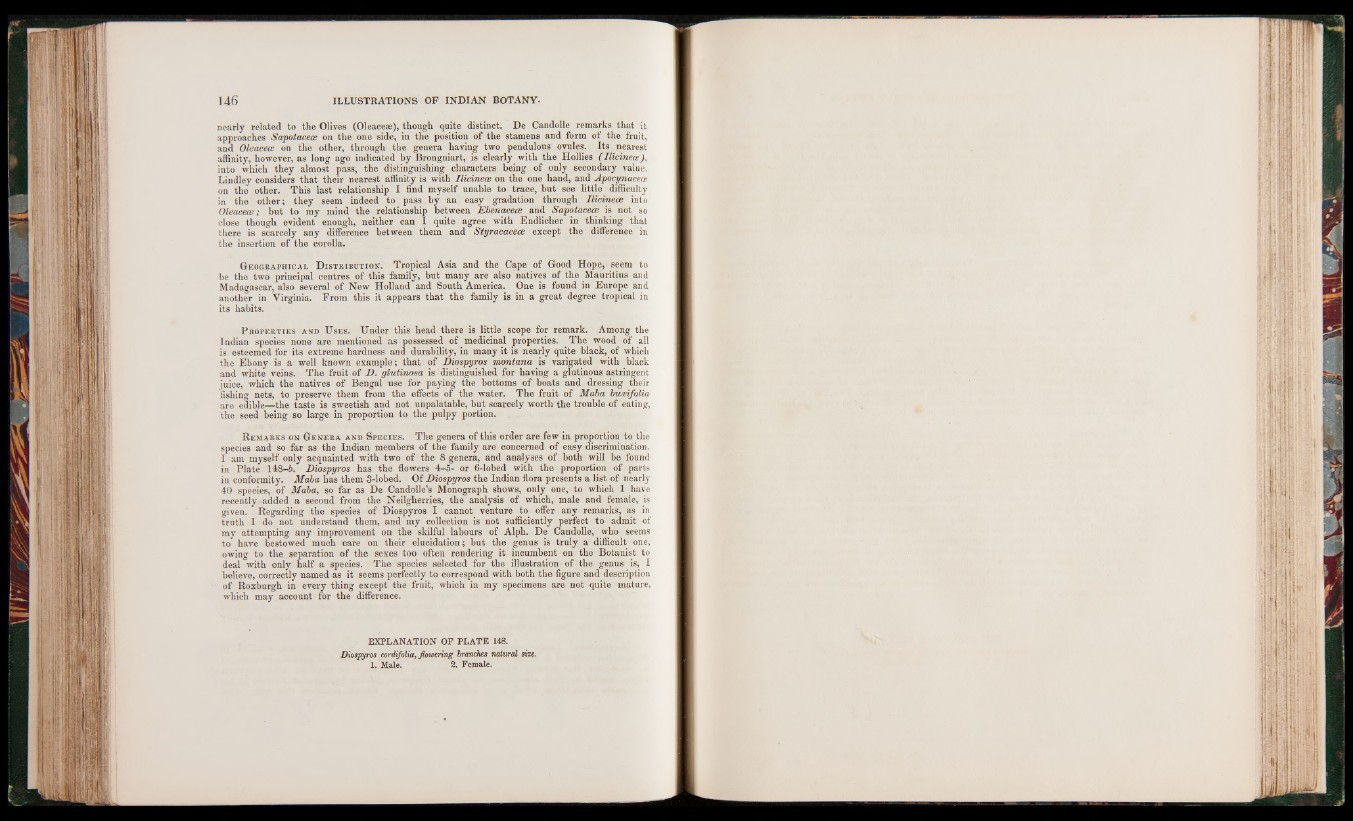
nearly related to the Olives (Oleacese), though quite distinct. De Candolle remarks that it
approaches Sapotaceoe on the one side, in the position of the stamens and form of the fruit,
and Oleacece on the other, through the genera having two pendulous ovules. Its nearest
affinity, however, as long ago indicated by Brongniart, is clearly with the Hollies ( Ilicinece),
into which they almost pass, the distinguishing characters being of only secondary value.
Lindley considers that their nearest affinity is with Ilicinece on the one hand, and Apocynaceoe
on the other. This last relationship I find myself unable to trace, but see little difficulty
in the other; they seem indeed to pass by an easy gradation through IlicinecE into
Oleacece; but to my mind the relationship between Ebenacece and Sapotacece is not so
close though evident enough, neither can I quite agree with Endlicher in thinking that
there is scarcely any difference between them and Styracacece except the difference in
the insertion of the corolla.
Geographical D istribution. Tropical Asia and the Cape of Good Hope, seem to
be the two principal centres of this family, but many are also natives of the Mauritius and
Madagascar, also several of New Holland and South America. One is found in Europe and
another in Virginia. From this it appears that the family is in a great degree tropical in
its habits.
P roperties and U ses. Under this head there is little scope for remark. Among the
Indian species none are mentioned as possessed of medicinal properties. The wood of all
is esteemed for its extreme hardness and durability, in many it is nearly quite black, of which
the Ebony is a well known example; that of Diospyros montana is varigated with black
and white veins. The fruit of D. glutinosa is distinguished for having a glutinous astringent
juice, which the natives of Bengal use for paying the bottoms of boats and dressing their
fishing nets, to preserve them from the effects of the water. The fruit of Maba buooifolia
are edible—the taste is sweetish and not unpalatable, but scarcely worth the trouble of eating,
the seed being so large in proportion to the pulpy portion.
R emarks on Genera and Species. The genera of this order are few in proportion to the
species and so far as the Indian members of the family are concerned of easy discrimination.
I am myself only acquainted with two of the 8 genera, and analyses of both will be found
in Plate 148-6. Diospyros has the flowers 4-5- or 6-lobed with the proportion of parts
in conformity. Maba has them 3-lobed. Of Diospyros the Indian flora presents a list of nearly
40 species, of Maba, so far as De Candolle’s Monograph shows, only one, to which I have
recently-added a second from the Neilgherries, the analysis of which, male and female, is
given. Regarding the species of Diospyros I cannot venture to offer any remarks, as in
truth I do not understand them, and my collection is not sufficiently perfect to admit of
my attempting any improvement on the skilful labours of Alph. De Candolle, who seems
to have bestowed much care on their elucidation; but the genus is truly a- difficult one,
owing to the separation of the sexes too often rendering it incumbent on the Botanist to
deal with only half a species. The species selected for the illustration of the genus is, I
believe, correctly named as it seems perfectly to correspond with both the figure and description
of Roxburgh in every thing except the fruit, which in my specimens are not quite mature,
which may account for the difference.
EXPLANATION OP PLATE 148.
Diospyros cordifolia, flowering branches natural size.
1. Male. 2. Female.